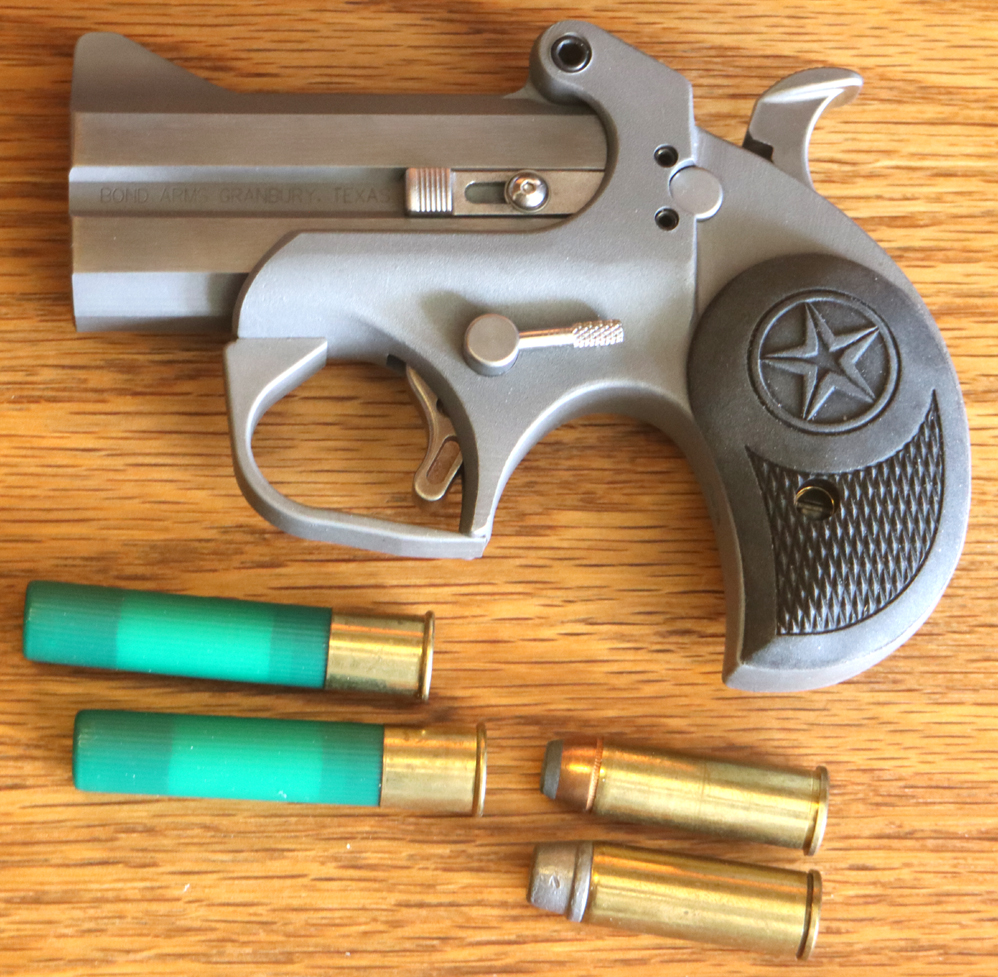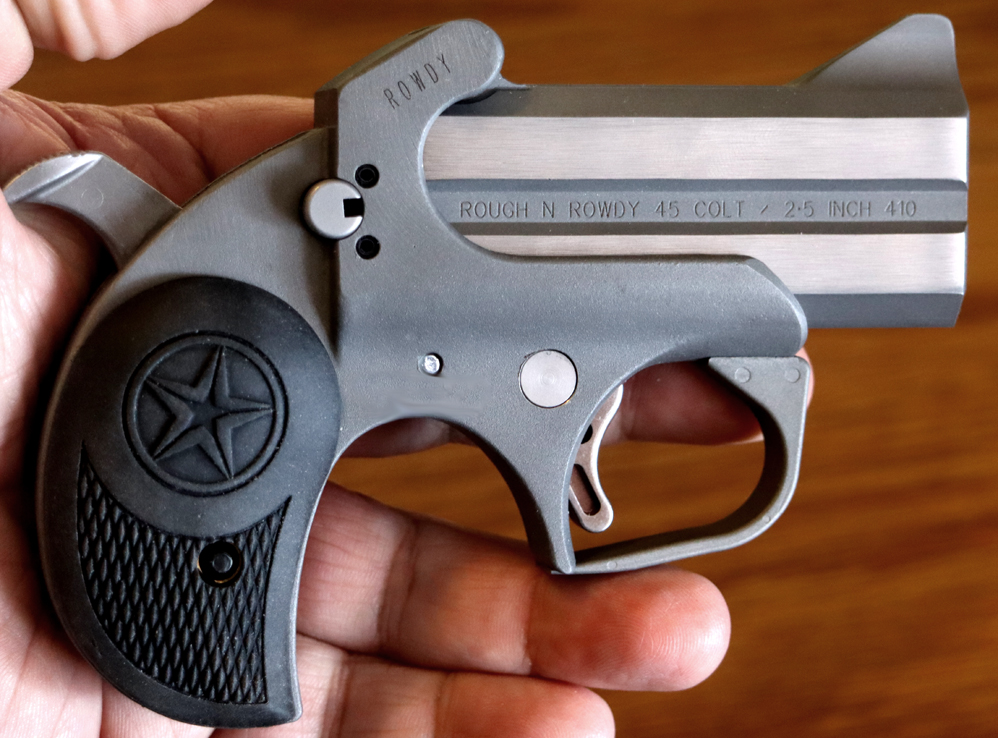
Bond Arms "Rowdy" Derringer
| Dimensions | Barrel Length | Weight | Caliber | Action Type | Magazine Capacity |
| 5" x 3.9" x 0.7" |
3" |
20 oz. |
.410/45 L.C. |
O\U Derringer |
2 |
This is one of the more interesting and crazier guns I own. To most people, this is a derringer, but Bond Arms calls it a double barrel handgun. The specs given above are nominal, because of the great variety of barrels and calibers available. More on that, further down. I have been considering a derringer for years, but most have been of such poor quality that there seemed no point. On the other hand, you get what you pay for. The little derringers out there tended to sell for less than $100, to perhaps $150. Most of these derringers are small, cheap, and badly made. These are made by companies like Cobray, Cobra, Bearman, and Davis.
Bond Arms does not make junk. They have been making derringers since 1995. Their guns are overbuilt from solid stainless billets machined into frames and barrel assemblies. The problem is that Bond Arms handguns generally sell for $500 to $700 or more. I have known of these guns for years, and considered them among the best, but for the same price as many M1911 models, a good P-35, or a decent revolver, it was a hard purchase to justify. Who would pay that much for a little derringer? To make a long story short, I wouldn't, but I was willing to pay a little less, and did.
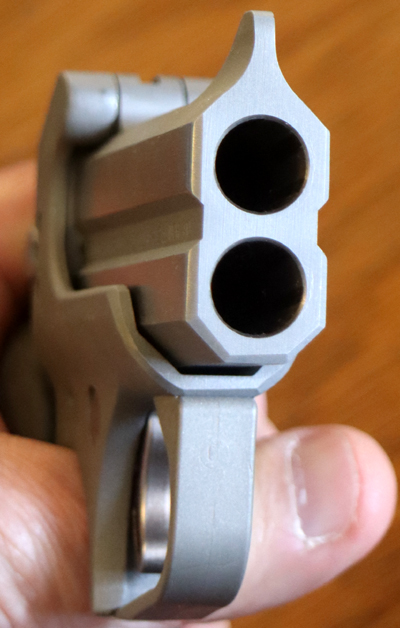 Enter the Bond Arms Rowdy. I wandered through a local
gunshop, and saw three Bond Arms
Rowdy derringers in a display case. One was in 9mm, one was
in 38/357, and one was in 410/45 L.C.The asking price was
around $300. Even this can seem a bit high, for a class of
firearm usually considered to run in the $100 range, but I
was intrigued. Out of curiosity I asked to see them. As soon
as I had one in my hand, I knew I was going to buy it. I
left the shop (no waiting period in Wisconsin) with a 410/45
version in a box under my arm, and a big smile on my face.
The smile is still there. Overall, I like this gun a lot -
really a lot. With its snap up barrel, release, and single
action trigger, it is very fidget friendly.
Enter the Bond Arms Rowdy. I wandered through a local
gunshop, and saw three Bond Arms
Rowdy derringers in a display case. One was in 9mm, one was
in 38/357, and one was in 410/45 L.C.The asking price was
around $300. Even this can seem a bit high, for a class of
firearm usually considered to run in the $100 range, but I
was intrigued. Out of curiosity I asked to see them. As soon
as I had one in my hand, I knew I was going to buy it. I
left the shop (no waiting period in Wisconsin) with a 410/45
version in a box under my arm, and a big smile on my face.
The smile is still there. Overall, I like this gun a lot -
really a lot. With its snap up barrel, release, and single
action trigger, it is very fidget friendly.I bought a Bond Arms Rowdy in 410, with a three inch barrel. It is one of a new line of firearms called the Rough and Ready series. These are Bond Arms answer to the question - why do your derringers sell for so much? The answer to the question is - they don't have to, but we are perfectionists. The new series is just as well made, of the same materiel and to the same design as the traditional Bond Arms designs. That's right - solid stainless steel construction, machined from billets. No pot metal castings or plastics are used. What these guns are missing is the same level of polish, the fancy grips, and the packaging. They are not perfect, but are pretty damned good. For half the price, I can live with that.
For all of that, these are some pretty nice looking guns. Though they do not have the jewel like quality of their more expensive brethren, the bead blasted finish is appropriate for a more utilitarian series, and for the whole idea of a roughneck series of firearms. Bond Arms probably could have gotten away with using molded plastic grips on this series, but instead use textured rubber, with their logo embossed. So even when they decide not to go fancy, they don't go cheap.
In common with the entire Bond Arms line, there are a number of barrel lengths and calibers available, once the initial purchase is made. Barrels range from 2.5" up to 6", in thirty seven caliber combinations. Barrels are universal, and can be purchased to provide caliber and length conversion, adding quite a bit to the versatility of the system.
The gun I bought features a three inch barrel in the popular 410/45 L.C. chambering. This can be considered a snake gun, a self defense gun, or perhaps a little gun to use for cowboy shooting. Something about firing a shotgun shell through this little derringer appealed to me. The 45 L.C. can be a bit hard to find, and a bit dear when found, but 410 shotgun shells are generally common and comparatively cheap.
Firing shot through a rifled barrel introduces some interesting complications. The spin of the rifling will tend to make the shot spread more quickly than an ordinary shotgun barrel. Additionally, there is nothing like a choke on this barrel. There are a couple of ways to deal with this. The first is to use very light rifling, which is the method used by Taurus and S&W in their 410 revolvers. Another method is a cloverleaf extension added to the end of the barrel, as was done in the old Thompson Contender 410 and Hotshot barrels. Bond Arms addresses this by having only a half inch section of the barrel lightly rifled. This tends to compromise accuracy for use of the 45 L.C. cartridge. For those
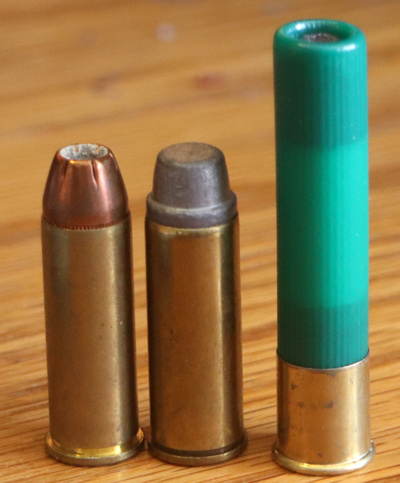 who wish top performance from the 45 L.C.
cartridge, Bond arms offers a barrel chambered in 45 L.C.
only, with conventional full length rifling. For this type
of weapon, out of a three inch barrel, it is likely not a
huge issue, but the option is there. Personally, I would
rather have the option to use shot shells.
who wish top performance from the 45 L.C.
cartridge, Bond arms offers a barrel chambered in 45 L.C.
only, with conventional full length rifling. For this type
of weapon, out of a three inch barrel, it is likely not a
huge issue, but the option is there. Personally, I would
rather have the option to use shot shells. As can be seen from the above photo, this makes for some pretty impressive holes in the front of the gun. Note the single billet construction. The sights are said to be calibrated for the lower barrel. Sights are simple, machined right into the barrel assembly, and though rudimentary, they are more than sufficient for the intended purpose of these little guns. One of the good things about this is that removing and replacing barrel assemblies does not mess up the point of aim.
To the right is a photo of the 45 L.C. cartridge, along with a 44 Magnum and a 410 shot shell. All three are impressive performing rounds. None are considered particularly easy to shoot. This is where the heavy construction, and twenty ounce weight really help. Also helpful with some of the more powerful rounds is the substantial width of these guns. In the grip area, the gun is a full inch wide. Other portions of the frame, including the trigger guard, are .70" with the barrel cradle curving back out to a full inch.
Shotgun shells, for all of their size, are low pressure rounds. The 45 L.C. was originally a black powder round, though modern smokeless rounds are now being produced. The company does warn not to use hot loads in these guns, and particularly warns against chambering the 454 Casull (which will fit) in this barrel. Common sense, and really, in a twenty ounce gun, who would want to fire such a round?
A few other things to keep in mind, for those new to derringer type pistols. Instead of the straight back squeeze that we have all been taught to cultivate, the trigger of a derringer needs to be pulled back and down. Attempting to squeeze it directly will result in a very hard trigger pull. This is not unique to the Bond Arms, and is a characteristic common to all derringer type pistols. The trigger is smooth, fairly wide, and once the knack of pulling it down si mastered ,the pull is relatively light.
A derringer is strictly a single action gun, so the hammer will need to be cocked for each shot. The hammer is wide, serrated, and a bit stiff. The bird's eye grip, which is a hallmark of the derringer, allows for the gun to pivot up. This is handy for helping redirect some of the recoil generated by such a small gun, and also allows for quick cocking for the next shot. This grip will tend to make the gun shoot a bit high, until the shooter gets used to it.
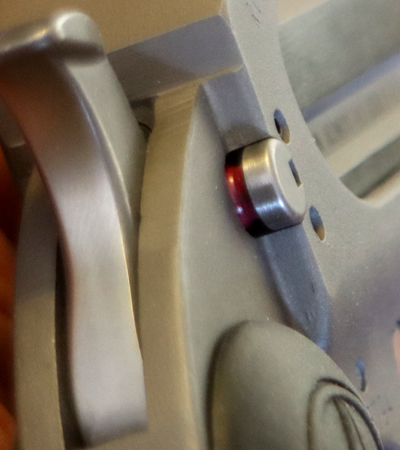 In general,
this is a very simple gun to operate. It is nearly
foolproof, and there is little go go wrong. No magazine,
slide, other controls to mess with. The size, trigger, and
sights tend make these difficult guns to shoot well.
Traditionally, a derringer is what you use from a few feet
to about twenty feet if that. The stereotypical belly gun.
In general,
this is a very simple gun to operate. It is nearly
foolproof, and there is little go go wrong. No magazine,
slide, other controls to mess with. The size, trigger, and
sights tend make these difficult guns to shoot well.
Traditionally, a derringer is what you use from a few feet
to about twenty feet if that. The stereotypical belly gun.The safety is a button, located in front of the hammer. Pressing it to the right allows the gun to fire, and shows a red indicator. Pressing it to the left blocks the hammer. The safety is positive, and registers a distinct click, when engaged or disengaged. The hammer block is a good idea. In general, a derringer is a pretty safe design, due to the single action operation, but no system is completely safe. In addition to the safety, the Bond Arms features a rebounding hammer and frame mounted firing pin. Finally, if the trigger is not completely back, the hammer will not fall all the way, nor can it be forced to make contact with the firing pin. This combination of features makes these guns very safe indeed, yet Bond Arms does warn not to carry the gun with the hammer cocked, even with the safety on.
Like all derringer style pistols, the Bond Arms uses a single trigger to fire each barrel in sequence. It starts with the lower barrel, which is calibrated with the sights, and thus more accurate. The single action trigger automatically switches from lower to upper barrel for the second shot. This resets when the gun is reloaded.
Derringers are reloaded by releasing the barrel assembly, and tipping it up, just the opposite as with a double rifle or shotgun, which normally tip down. The barrel assembly is unlocked with a lever on the left side of the frame, under the barrels. The lever is pressed down, and a spring in the barrel extractor pushes the barrel up just a bit, to clear the frame latch. Not all barrel assemblies have this extractor. It is unique revolver or shotgun cartridge chambers, for reasons that will be addressed below. Tipping the barrels up completely allows the spent cartridges to be removed, and fresh cartridges to be loaded. The assembly may then be tipped back down, and locked in place.
The photo shows the barrel tipped up, with the extractor
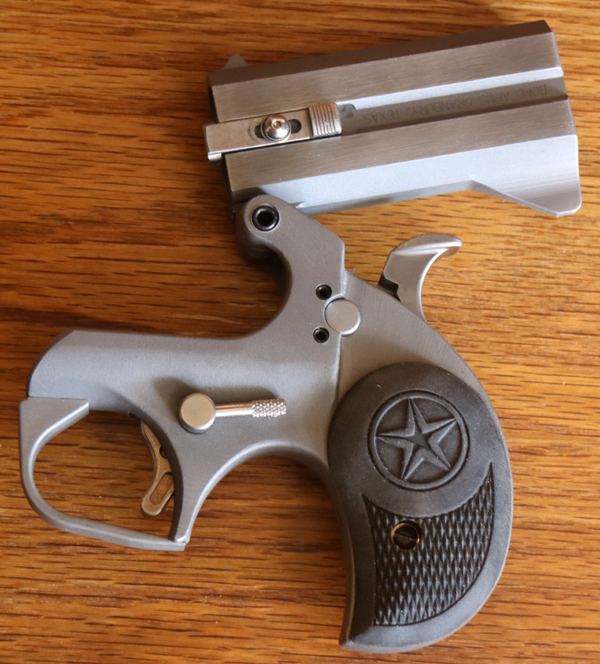 visible on the side of the barrel assembly,
between the barrels. Not all barrels feature extractors.
They are limited to calibers that chamber revolver or
shotgun rounds. The reason is pretty simple. Semi auto
cartridges use extraction grooves, rather than rims. Rimless
cartridges require hook style extractors that are spring
loaded and do not really lend themselves to manual
operation. Attempting to use such an extractor on a
derringer style handgun introduces a delicate and
complicated mechanism that really confers no advantage.
Additionally, a rimless round has the possibility of getting
stuck under such an extractor and impairing function.
visible on the side of the barrel assembly,
between the barrels. Not all barrels feature extractors.
They are limited to calibers that chamber revolver or
shotgun rounds. The reason is pretty simple. Semi auto
cartridges use extraction grooves, rather than rims. Rimless
cartridges require hook style extractors that are spring
loaded and do not really lend themselves to manual
operation. Attempting to use such an extractor on a
derringer style handgun introduces a delicate and
complicated mechanism that really confers no advantage.
Additionally, a rimless round has the possibility of getting
stuck under such an extractor and impairing function. Cleaning is pretty simple. Except for the hammer, trigger, and firing pin, nothing moves or cycles during shooting. No disassembly is required or recommended. Tip up the barrel, clean the chambers, lubricate, then tip down the barrel. Done. Cleaning is not a huge deal on such a simple mechanism, particularly when constructed of stainless steel. The stainless construction also lends itself to deep concealment, and the use of classic leather holsters and gear.
The trigger guard is removable, for those who prefer the classic exposed derringer trigger. I prefer to leave the guard in place. Grips are also easily removable, though I find the rubber set included, to be just fine. I have read complaints of the grip separating from the screws, but have so far had no such issues. Should such a thing ever occur, the new grips will likely be of wood. I am also flirting with the idea of putting a mirror polish on the barrel.
The view here, of the action open, indicates why Bond Arms likes to describe its products as double barrel handguns, rather than derringers. The construction bears a striking resemblance to a class O/U shotgun or rifle. Note that the hinged barrel assembly flops down to close within a cradle that supports it at the back and sides. The chambers are counterbored, and do not quite touch the frame of the gun. this allows recoil to float the spent casings from the chambers. Also note the twin firing pins.
Behind where the barrels rest, are the firing pins. The third marking in the frame, off center from the two firing
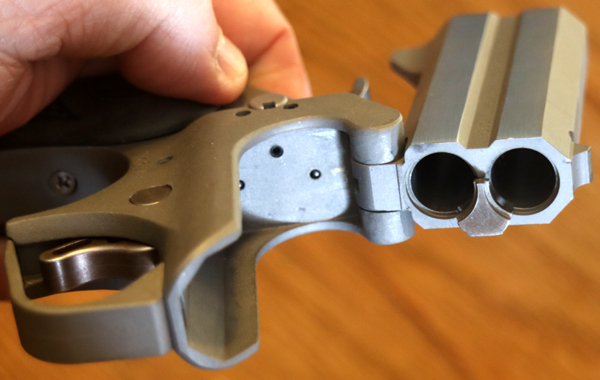 pins, is the
security lock. A tiny hex wrench can be used to lock the
action and render the gun unable to fire, for storage or
transport.
pins, is the
security lock. A tiny hex wrench can be used to lock the
action and render the gun unable to fire, for storage or
transport.The type of stainless steel used for these guns is magnetic, and Bond Arms was offering magnetic gun holders. I have some magnets set up in a couple locations, to take advantage of this. One thing to remember though is that metal scratches. A magnet is best covered in duct tape or some other such thing, unless you can live with scratches on the blasted stainless finish. Please also note that scratches on bead blast are not easily buffed out as they are on a brushed finish, since bead blasting has no grain.
No surprises here. A 410 shotgun shell out of a three inch barrel from a twenty ounce gun, kicks a bit. Firing this little gun in this chambering is fun, but not something you want to do all day. Accuracy is good enough at the fifteen foot minimum range required where I shoot, that I can absolutely hit within the lethal areas. Further out, things open up a bit. Derringers are not target guns.Twenty feet is considered maximum range, and is reflected in the sights mounted. At fifteen feet, the entire target is peppered with little holes. Even in the dark, against a moving target, and shooting fast, you are unlikely to miss.
Overall, I like this little gun quite a bit. It is a great knock-around gun, especially at this price. I can easily see tossing it in a backpack, a pocket, a tackle box, or glove compartment. I can take a lesson from the old timers, and stuff it in a boot or vest pocket. It is not a gun that requires a lot of care, thought, or worry. In these times of laser sights, polymer pistols, high capacity magazines, and multi control wonder
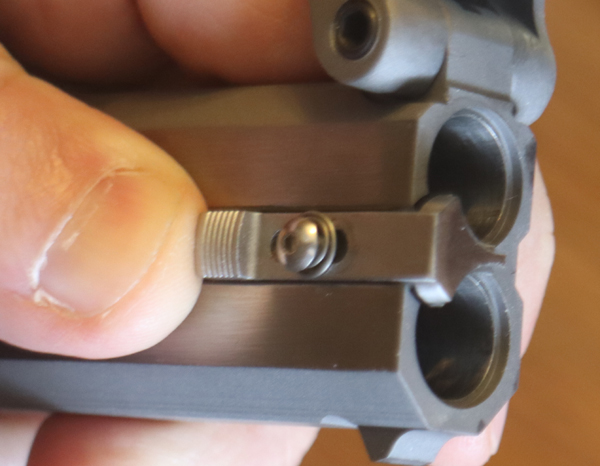 pistols, I am becoming ever more attracted
to the simplicity of certain designs. The relative
simplicity and durability of revolvers, double rifles and
shotguns, and single action triggers are reassuring,
particularly when rendered in stainless.
pistols, I am becoming ever more attracted
to the simplicity of certain designs. The relative
simplicity and durability of revolvers, double rifles and
shotguns, and single action triggers are reassuring,
particularly when rendered in stainless. One very interesting thing about these little guns is that they hold the potential to be a system, of sorts. Bond Arms makes all of their barrels to a certain design standard. This allows any barrel to be mounted on any frame. Part of the reason is the way the barrel attaches to the frame. The hinge on the upper part of the frame is held by a hex screw that is easily removed.
In addition to the 45 L.C. barrel, I have ordered a 38/357, and will probably order a 9mm, and a 45 ACP. Barrels for the rimless semi auto rounds have no extractor, but do feature a cut out for easy removal of spent casings. A 22 L.R. barrel will probably be next. As of this writing, Bond Arms does not make such a barrel, but they can be found on the used market.
Having a multi barrel, multi caliber system like this is a bit reminiscent of the old Thompson contender. For hard times, when ammunition may be in short supply, or certain rounds may be unavailable, the idea of a multi caliber system has a certain SHTF appeal.
